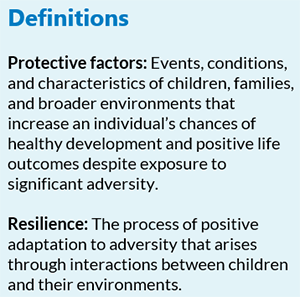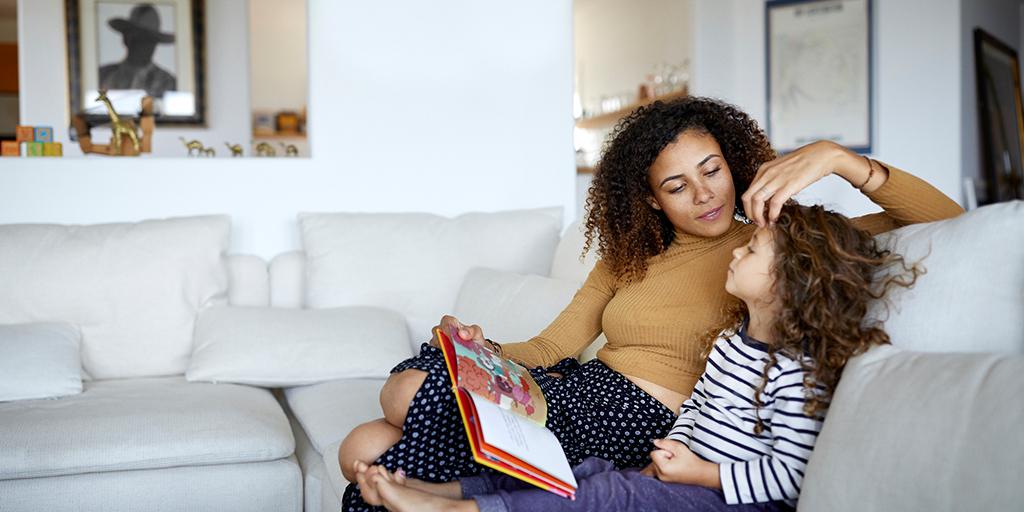Ways to Promote Children’s Resilience to the COVID-19 Pandemic
The COVID-19 pandemic and its associated social and economic stressors can undermine children’s development and well-being. Not only must they cope with major changes to everyday life, such as physical distancing and home confinement, but their families may struggle to meet their basic physical and emotional needs. Rates of poverty, unemployment, parental mental health problems and substance abuse, child abuse and neglect, and intimate partner violence tend to rise during disasters. Children may not receive critical supports they need when community services are limited and fewer adults have direct contact with children.
The good news is that over four decades of research on resilience shows that protective factors can buffer children from harm and increase the chances they adapt positively to adversities such as the COVID-19 pandemic. Families and communities can work together to promote these protective factors.
Protective factor #1: Sensitive, responsive caregiving
 The primary factor in a child’s recovery from an adverse or traumatic event is the presence of a sensitive and caring adult. To support healthy child development during COVID-19, children and youth need to maintain regular age-appropriate connections to important adults in their lives. For example, young children may need more face-to-face time for connection than older children and adolescents, who are able to connect virtually.
The primary factor in a child’s recovery from an adverse or traumatic event is the presence of a sensitive and caring adult. To support healthy child development during COVID-19, children and youth need to maintain regular age-appropriate connections to important adults in their lives. For example, young children may need more face-to-face time for connection than older children and adolescents, who are able to connect virtually.
Parents and other caregivers can:
- Spend quality time with children. Even short periods of time playing, reading, going outdoors, and talking can bolster children’s sense of safety and security during uncertain or scary times.
- Stay connected even when physical separation is necessary for safety reasons. Set up times for children to talk to distant caregivers using online video chats, telephone calls, emails, texts, or letters. These connections are important in helping children feel secure and supported during the pandemic.
Communities, states, tribes, and territories can:
- Offer strategies and supplies to allow adults who are not living with the child (e.g., biological parents, grandparents, child care providers, teachers) and professionals who work with families (e.g., home visitors, parenting programs) to maintain connections (e.g., activities, equipment, internet).
- Provide resources to families on meaningful, age-appropriate ways to spend time with and talk to children during the pandemic.
Protective factor #2: Meeting basic needs
Meeting the basic needs of children and families—such as food, shelter, clothing, and medical and mental health care—is essential to protecting children’s well-being in stressful times. Actively mobilizing tangible resources for families during the pandemic is especially important for families experiencing additional risks, such as economic instability, job loss, and health or mental health needs.
Parents and other caregivers can:
- Know that asking for help is a sign of strength and resourcefulness, not weakness.
- Identify helpful local services through a child’s current service provider, school, or early care and education program; or through local agency websites and hotlines, family resource centers, or community resource specialists (e.g., 211).
Communities, states, tribes, and territories can:
- Help families identify community services that are operating through direct outreach to vulnerable families and public awareness campaigns.
- Reduce barriers to accessing services by increasing service delivery options and by conducting targeted outreach to marginalized and vulnerable families, including those affected by COVID-19-related racism and stigma.
Download

Protective factor #3: Emotional support for children
Emotional and behavioral changes in children are to be expected during a pandemic, as everyone adjusts to a changes in daily routines. Some children may show signs of emotional distress (e.g., clinginess, anxiety, sadness, anger). But with strong emotional support from adults and communities, most children will return to their typical level of functioning from before the pandemic.
Parents and other caregivers can:
- Use the 3 Rs (reassurance, routines, regulation): Reassure children about their safety and the safety of loved ones; maintain predictable routines (e.g., sleeping, eating, learning, playing); support children’s regulation skills by helping them manage difficult feelings (e.g., deep breathing, movement, quiet time); and make time for emotional “check-ins” (e.g., offer opportunities for children to ask questions, talk about their feelings, and get age-appropriate information and support).
- Emphasize the positive. Stories of hope and resilience (e.g., people helping each other or animals) provide an important counterbalance to negativity and fear about the pandemic. If books are unavailable at home, try accessing free online books for children and teens.
Communities, states, tribes, and territories can:
- Facilitate families’ access to home visiting, early intervention, child and family mental health programs, teachers, and other services by offering remote options for remaining in contact with children and their families (e.g., telephone or video contact, including telehealth).
Protective factor #4: Support for caregiver well-being
When parents’ and other caregivers’ needs are met, children are more likely to receive sensitive and responsive care. Protecting adults’ mental and physical health is an effective strategy for promoting children’s well-being during and after a pandemic.
Parents and other caregivers can:
- Whenever possible, prioritize time and energy for activities that are most important and meaningful to caregivers and their families (e.g., enjoyable activities with family at home, celebrating birthdays and other important milestones, connecting with friends) and focus on what can be reasonably accomplished under the circumstances.
- Take breaks from work and caregiving responsibilities: Even short periods of time spent on self-care (e.g., rest, exercise, mindfulness, reading, praying) can benefit the whole family.
- Reach out to family members, friends, religious groups, and professionals who can offer support for managing emotional and mental health challenges, such as stress, anxiety, and depression.
Communities, states, tribes, and territories can:
- Actively provide outreach to known vulnerable families and offer concrete informational resources on nutrition, housing, clothing, and mental and physical health.
- Ensure that mental and physical health services are available to parents and caregivers even when in-person contact with a provider is not possible (e.g., telebehavioral health, telemedicine).
Protective factor #5: Social connectedness
Postive social connections are important protective factors for both children and adults during a pandemic. Although in-person contact may be limited, physical distancing should not turn into social isolation, which is a risk factor for child abuse and neglect, adult and youth substance use, and family violence. During disasters, children interact less frequently with mandated reporters and other adults who could recognize and report signs of trouble in a family. Monitoring children’s safety is especially important during the pandemic.
Parents and other caregivers can:
- Spend virtual time regularly with extended family members and friends (e.g., online or by mail, depending on each family’s resources).
- Encourage older children and teens to stay socially connected virtually.
- When time is limited, focus on connections with family, friends, religious figures, service providers, or others who offer the most helpful types of support.
- Connect to others through common hobbies and opportunities to help in the community, which can be rewarding and meaningful (e.g., donating supplies, writing letters to older adults).
- Reach out to other families with children to check on their well-being and offer support.
Communities, states, tribes, and territories can:
- Offer regular opportunities for children and their caregivers to connect virtually (e.g., online, telephone) with one another through cultural activities, education, hobbies, support groups, and other community gatherings.
- Conduct regular check-ins with families (by phone or online) with children who experienced threats to their safety (e.g., child abuse and neglect, intimate partner violence, substance abuse, mental illness) prior to the pandemic. Professionals who are permitted by their agencies (within established safety guidelines) may conduct home visits to check in with families.
Other COVID-19 Resources
- Resources for Supporting Children’s Emotional Well-being during the COVID-19 Pandemic
- States can do more to help students access nutritious school meals during pandemic-related school closures
- COVID-19’s forgotten children
- During the COVID-19 pandemic, telehealth can help connect home visiting services to families
- As COVID-19 spreads, most states have laws that address how schools should respond to pandemics
- School-based health centers can deliver care to vulnerable populations during the COVID-19 pandemic
© Copyright 2024 ChildTrendsPrivacy Statement
Newsletter SignupLinkedInThreadsYouTube